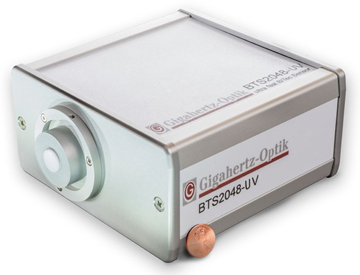BTS2048-UV BiTec Sensor UV Spectroradiometer
Absolute UV Spectral Irradiance Measurement Down to 200 nm

Optical bandwidth of 0.8nm guarantees precise measurement of any type light source including quasi-monochromatic UV LEDs.
CCD spectroradiometer specifically designed for the UV spectral range with a very high efficiency grating to be employed with a very high spectral resolution. In addition, optical filters can be used to significantly reduce stray light.
UV Dedicated Spectroradiometer vs. General Broadband Spectrometer
Conventional CCD detector spectral response typically ranges from 200 to 1100 nm. Often this wide spectral range is specified as the response range of the spectroradiometer. However, this fails to consider the spectral response function of the dispersion grating, which reduces the detector's responsivity in the UV spectrum because it is designed for broadband use. This results in significant errors in UV measurement accuracy primarily through long-wave stray light error. The spectral resolution of broadband spectrometers is typically not sufficient to guarantee precise measurements of narrowband light sources like UV LEDs.
CCD spectroradiometers that are specifically designed with UV gratings feature a very high grating efficiency with fine spectral resolution. Additionally the BTS2048-UV uses optical filters to significantly reduce stray light further.
Bi-Tec Sensor UV Spectroradiometer
BTS stands for Bi-Technology Sensor which combines the properties of a photodiode with those of a CCD array. Through bilateral correction of both sensors' measurements accurate results over a wide dynamic range are realized. The BiTec Sensor allows the measurement of irradiance, spectral irradiance, radiant intensity, spectral radiant intensity, radiant power and intensity with integrating sphere or goniometer option.
UV Optimized & TE Cooled
The BTS2048-UV 2048 pixel CCD array has a useable spectral responsivity range between 190 nm and 430 nm with a 0.8 nm optical bandwidth and a pixel resolution of 0.13nm/pixel. Due to its back-thinned technology, this CCD chip is substantially more sensitive as compared to conventional front-illuminated CCD chips. Furthermore the CCD is one stage cooled (1TEC).
Ultrafast response times are achieved using three processors, a LAN interface and electronic shutter. An internally controlled filter wheel combined with smart stray light correction and measurement routines enable high quality absolute UV measurements down to 200nm.
Cosine Corrected — No Light Guide
A unique feature is its cosine diffuser input optic (f2 ≤ 3 %). No light guide means improved sensitivity and calibration stability. Also this allows the BTS2048-UV to mechanically mount to complementary products including integrating spheres, radiant intensity barrels, goniometers and custom designed components suited for a particular industrial, medical or research application.
Absolute calibration of Spectral Irradiance down to 200 nm
Gigahertz-Optik's DAkkS accredited calibration laboratory (D-K-15047-01-00) is able to perform traceable calibrations down to 200 nm. This allows the BTS2048-UV to accurately measure UV-C LEDs. For the shortwave spectral range a specially designed deuterium lamp-based calibration strategy has been devised. The BTS2048-UV is traceably calibrated and certified to international NMI standards.
User Software Supplied — SDK Available
S-BTS2048 user software supplied with the BTS2048-UV spectroradiometer offers a flexible desktop that can be individually configured to display all graphical and numerical data taken or only those measurement parameters of interest. An SDK option is also available.
User software and developer software
The standard S-BTS2048 user software has a customizable user interface and offers a large number of display and function modules which can be activated when configuring the BTS2048-UV with the respective accessory components from Gigahertz-Optik GmbH. The S-SDK-BTS2048 developer software is offered for the integration of the BTS2048-VL in the customer's own software.
Product Specifications
For complete technical specifications: please visit the Gigahertz-Optik main website here.
